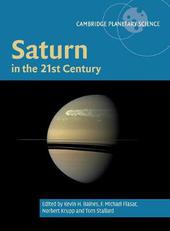
|
Saturn in the 21st Century
Hardback
Main Details
Description
The Cassini Orbiter mission, launched in 1997, has provided state-of-the-art information into the origins and workings of Saturn. Drawing from new discoveries and scientific insight from the mission, this book provides a detailed overview of the planet as revealed by Cassini. Chapters by eminent planetary scientists and researchers from across the world comprehensively review the current state of knowledge regarding Saturn's formation, interior, atmosphere, ionosphere, thermosphere and magnetosphere. Specialised chapters discuss the planet's seasonal variability; the circulation of strong zonal winds; the constantly changing polar aurorae; and the Great Storm of 2010-2011, the most powerful convective storm ever witnessed by humankind. Documenting the latest research on the planet, from its formation to how it operates today, this is an essential reference for graduate students, researchers and planetary scientists.
Author Biography
Kevin H. Baines is a Senior Scientist at the Space Science and Engineering Center, at the University of Wisconsin, Madison, and Principal Scientist at California Institute of Technology/Jet Propulsion Laboratory, Pasadena. He has over 35 years of experience in the development, planning, data analysis and publication of science results from NASA and ESA planetary orbital missions. Specializing in the 3-D nature of planetary atmospheres as gleaned from spacecraft-borne visual-to-near-infrared spectral imagers, he has been a NASA-selected scientist on the Cassini-Huygens and Galileo orbiter missions to Jupiter and Saturn and was the leader of the NASA science team on ESA's Venus Express orbiter mission. F. Michael Flasar is a Space Scientist at the Planetary Systems Laboratory, at NASA's Goddard Space Flight Center. He has devoted 45 years to the study of solar system planets and their atmospheres, particularly from thermal-infrared spectroscopy and radio-occultation data. He has been an investigator on the Voyager mission to the giant planets, the Galileo mission to Jupiter, the Mars Global Surveyor mission, and the Cassini-Huygens mission to Saturn. He is a recipient of NASA Goddard Space Flight Center's John C. Lindsay Memorial Award for Space Science, and is a Fellow of the American Geophysical Union. Norbert Krupp is a Scientist at the Max-Planck-Institut fur Sonnensystemforschung, Goettingen. He has 25 years of experience in the data analysis and development of space instrumentation. His main interest is the understanding of processes driving the global configuration and dynamics of particles around planets including the interaction with moons, rings and neutral clouds. He has been involved in several space missions, including: Mars Express, Venus Express, Ulysses, Bepi Colombo, Juice, Galileo, Cassini/Huygens, and Europa Clipper. On Cassini, he co-led the magnetosphere and plasma science working group MAPS, and is now a Co-Investigator of the MIMI instrument. Tom Stallard is an Associate Professor in Planetary Astronomy at the University of Leicester. He is a world-leading planetary astronomer who has observed the gas giants of our solar system from many of the largest telescopes around the world. Focusing on the investigation of aurora of these planets, he has also been extensively involved in analysing spacecraft data, including images of Saturn's aurora taken by the Cassini spacecraft. He has also appeared on numerous television and radio programmes to discuss recent science advances. His public outreach has included involvement in BBC Stargazing live events and he was awarded the honorary title of 'Hoku Kolea' for his extensive work with the Mauna Kea Visitor Information Station.
Reviews'This volume summarizes what has been gleaned from the gigantic trove of data collected by that mission; each of the 14 chapters was written by a group of experts chosen by the editors. ... until another mission visits the planet, this will be the definitive reference book on Saturn for graduate students and planetary scientists.' T. D. Oswalt, Choice
|